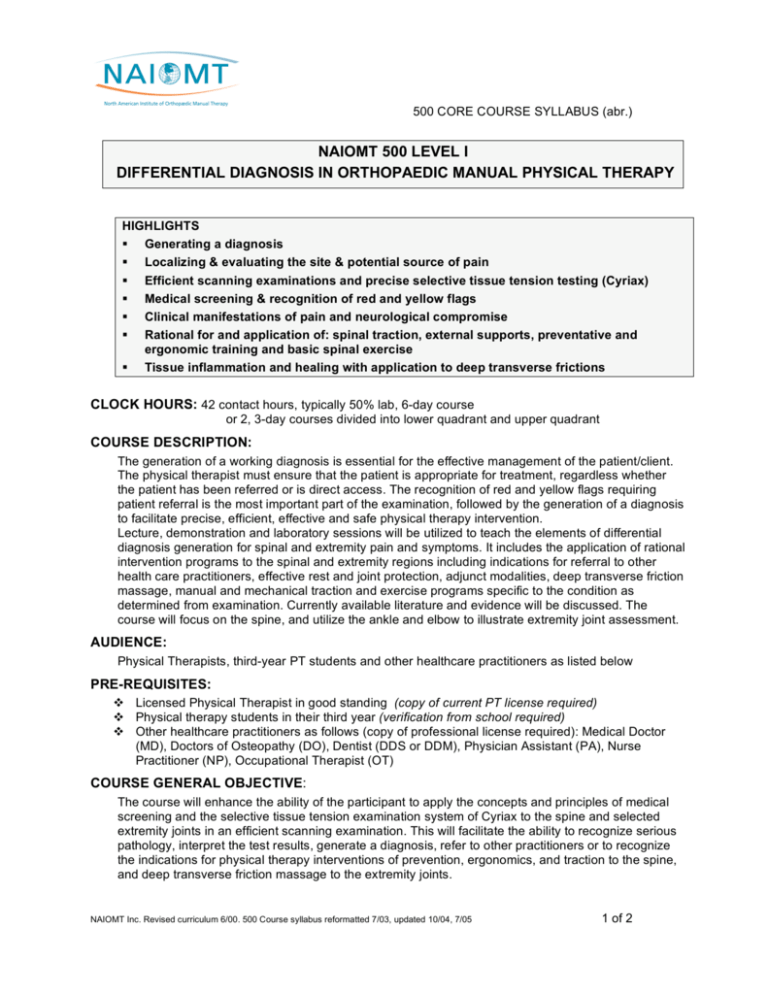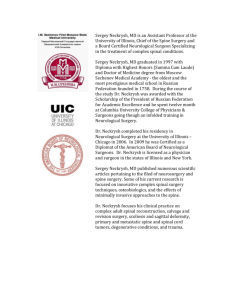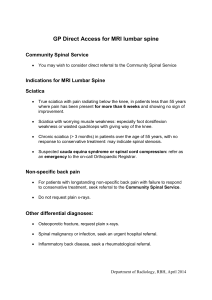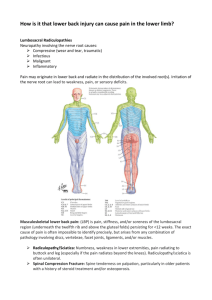naiomt 500 level i differential diagnosis in orthopaedic
advertisement

500 CORE COURSE SYLLABUS (abr.) NAIOMT 500 LEVEL I DIFFERENTIAL DIAGNOSIS IN ORTHOPAEDIC MANUAL PHYSICAL THERAPY HIGHLIGHTS Generating a diagnosis Localizing & evaluating the site & potential source of pain Efficient scanning examinations and precise selective tissue tension testing (Cyriax) Medical screening & recognition of red and yellow flags Clinical manifestations of pain and neurological compromise Rational for and application of: spinal traction, external supports, preventative and ergonomic training and basic spinal exercise Tissue inflammation and healing with application to deep transverse frictions CLOCK HOURS: 42 contact hours, typically 50% lab, 6-day course or 2, 3-day courses divided into lower quadrant and upper quadrant COURSE DESCRIPTION: The generation of a working diagnosis is essential for the effective management of the patient/client. The physical therapist must ensure that the patient is appropriate for treatment, regardless whether the patient has been referred or is direct access. The recognition of red and yellow flags requiring patient referral is the most important part of the examination, followed by the generation of a diagnosis to facilitate precise, efficient, effective and safe physical therapy intervention. Lecture, demonstration and laboratory sessions will be utilized to teach the elements of differential diagnosis generation for spinal and extremity pain and symptoms. It includes the application of rational intervention programs to the spinal and extremity regions including indications for referral to other health care practitioners, effective rest and joint protection, adjunct modalities, deep transverse friction massage, manual and mechanical traction and exercise programs specific to the condition as determined from examination. Currently available literature and evidence will be discussed. The course will focus on the spine, and utilize the ankle and elbow to illustrate extremity joint assessment. AUDIENCE: Physical Therapists, third-year PT students and other healthcare practitioners as listed below PRE-REQUISITES: Licensed Physical Therapist in good standing (copy of current PT license required) Physical therapy students in their third year (verification from school required) Other healthcare practitioners as follows (copy of professional license required): Medical Doctor (MD), Doctors of Osteopathy (DO), Dentist (DDS or DDM), Physician Assistant (PA), Nurse Practitioner (NP), Occupational Therapist (OT) COURSE GENERAL OBJECTIVE: The course will enhance the ability of the participant to apply the concepts and principles of medical screening and the selective tissue tension examination system of Cyriax to the spine and selected extremity joints in an efficient scanning examination. This will facilitate the ability to recognize serious pathology, interpret the test results, generate a diagnosis, refer to other practitioners or to recognize the indications for physical therapy interventions of prevention, ergonomics, and traction to the spine, and deep transverse friction massage to the extremity joints. NAIOMT Inc. Revised curriculum 6/00. 500 Course syllabus reformatted 7/03, updated 10/04, 7/05 1 of 2 500 CORE COURSE SYLLABUS (abr.) SPECIFIC COURSE OBJECTIVES: At the completion of this course, the participants will be able to: 1. Apply the concepts and principles of the selective tissue tension testing system to the spine and extremity joints and recognize, interpret and appraise the test results of the following: a. contractile and inert tissues lesions b. dural and neural mobility problems c. spinal cord, spinal nerve and nerve root compression/compromise signs and symptoms d. peripheral nerve compression/compromise signs and symptom e. normal and abnormal end feels to motion f. capsular and non-capsular patterns of restriction g. tendonitis, tendonosis, tenosynovitis and bursitis h. resisted/resistive tests 2. Efficiently perform basic history, systems review and tests and measures scanning examinations of the cervical, thoracic, lumbo/sacral spine, ankle and elbow as follows: a. A complete and detailed history and systems review b. Active, passive & resisted (resistive) tests to determine status of tissues c. Routine neuromeningeal tension/mobility tests d. Neurological tests of function spinal nerve, nerve root, peripheral nerve e. Neurological tests for function of CNS including dynamic stretch reflexes (deep tendon, clonus), nociceptive reflexes (Babinski, Hoffman etc.) f. General stress tests (including compression, traction, craniovertebral, postero/anterior pressures, general lumbar torsion, sacroiliac, peripheral ligamentous) g. Dizziness screening of indicators of serious pathology h. Special tests: vertebral artery insufficiency screening, neuromeningeal tests etc. 3. Recognize the presence of serious or worsening neurological signs 4. Recognize red and yellow flags and plan the appropriate course of action 5. Develop a provisional diagnosis and prognosis to enable the implementation of rational intervention 6. Identify and categorize the musculoskeletal structures or functions that require intervention or further examination, including: posture, articular & soft tissue, neurological, dural, vascular and adjacent joints 7. Analyze exam data including relevant pathology to assess patient’s problem list, including: etiology, nature, severity, irritability, contractile versus inert, or musculoskeletal pain mimickers 8. Apply theories of inflammation and wound repair/healing to deep transverse friction application 9. Identify indications, and contraindications of manual and mechanical spinal traction and apply principles of its effect and application 10. Demonstrate safe and effective non-specific manual cervical, thoracic and lumbar traction 11. Apply the principles of the effect and application of basic spinal exercise protocols. 12. Efficiently perform instruction and training in preventative spinal care and improved ergonomics 13. Recognize indications and contraindications spinal orthotics or external support 14. Efficiently record examination data, problems, plans and procedures 15. Apply knowledge of the mechanism and clinical manifestations of pain and dysaesthesias 16. Identify and interpret normal and abnormal end-feels and specific sites of pain or swelling in and around the spinal and extremity joint 17. Communicate to peers, other medical professions and lay persons using the current terminology of orthopaedic manual physical therapy and provide information resources on the sub-specialty 18. Discuss currently available literature and evidence for examination and intervention The descriptions of the minimum course components may vary according to the instructor’s assessment of the needs or expertise of the class. Some areas may be covered in guided independent study. NAIOMT Inc. (Revised curriculum 6/00. 500 Course syllabus reformatted 7/03, updated 10/04, 7/05 2 of 2







